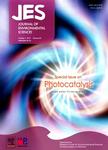Genotoxicity evaluation of drinking water sources in human peripheral blood lymphocytes using the comet assay
Genotoxicity evaluation of drinking water sources in human peripheral blood lymphocytes using the comet assay作者机构:State Key Laboratory of Pollution Control and Resource Reuse School of the Environment Nanjing University Nanjing 210093 China Jiangsu Institute of Planned Parenthood Research Nanjing 210036 China
出 版 物:《Journal of Environmental Sciences》 (环境科学学报(英文版))
年 卷 期:2008年第20卷第4期
页 面:487-491页
核心收录:
学科分类:0830[工学-环境科学与工程(可授工学、理学、农学学位)] 08[工学] 0815[工学-水利工程]
基 金:This work was supported by the Jiangsu Social Develop-ment Project Foundation (No. BS2001039 BS2007049)
主 题:comet assay drinking water sources genotoxicity human peripheral blood lymphocyte
摘 要:The potential harm of organic pollutants in drinking water to human health is widely focused on in the wodd; more and more pollutants with genotoxic substances are released into the aquatic environment. Water source samples were collected from 7 different localities of Nanjing City. The potential genotoxicity of organic extracts from drinking water sources were investigated by means of the comet assay in human peripheral lymphocytes. The results showed that all the organic extracts from all the water source samples could induce DNA damages of human peripheral blood lymphocytes at different levels. A significant difference (P 〈 0.01) was observed when compared with the solvent control, The DNA damage increased with the increase of the dosage of the original water source. Significant differences of DNA damage were observed in different drinking water sources, as shown by the multiple comparisons analysis at the dosage of 100x; the degree of DNA damage treated by Hushu waterworks (at town level) was the most serious, the arbitrary units (AU) was 141.62±6.96, however, that of Shangyuanmen waterworks (at city level) was only 109.64±2.97. The analysis also revealed that the genotoxicity of town's water sources was higher than that of the city. The results demonstrated that the comet assay can be successfully applied to the genotoxicity monitoring programs of drinking water sources.



